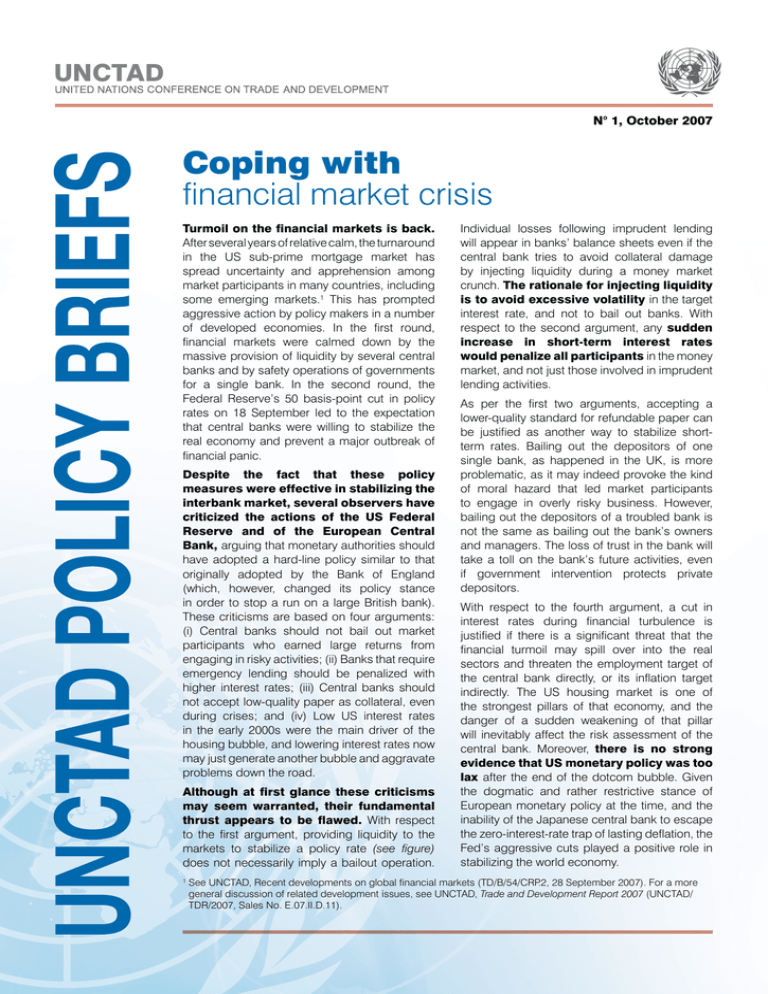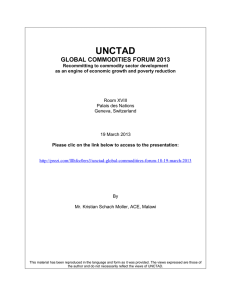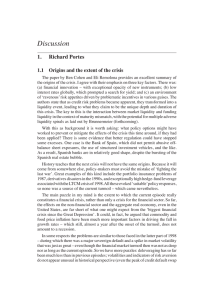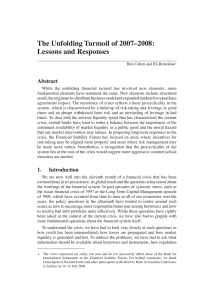Coping with financial market crisis UNCTAD N° 1, October 2007
advertisement

UNCTAD N° 1, October 2007 Coping with financial market crisis Turmoil on the financial markets is back. After several years of relative calm, the turnaround in the US sub-prime mortgage market has spread uncertainty and apprehension among market participants in many countries, including some emerging markets.1 This has prompted aggressive action by policy makers in a number of developed economies. In the first round, financial markets were calmed down by the massive provision of liquidity by several central banks and by safety operations of governments for a single bank. In the second round, the Federal Reserve’s 50 basis-point cut in policy rates on 18 September led to the expectation that central banks were willing to stabilize the real economy and prevent a major outbreak of financial panic. Despite the fact that these policy measures were effective in stabilizing the interbank market, several observers have criticized the actions of the US Federal Reserve and of the European Central Bank, arguing that monetary authorities should have adopted a hard-line policy similar to that originally adopted by the Bank of England (which, however, changed its policy stance in order to stop a run on a large British bank). These criticisms are based on four arguments: (i) Central banks should not bail out market participants who earned large returns from engaging in risky activities; (ii) Banks that require emergency lending should be penalized with higher interest rates; (iii) Central banks should not accept low-quality paper as collateral, even during crises; and (iv) Low US interest rates in the early 2000s were the main driver of the housing bubble, and lowering interest rates now may just generate another bubble and aggravate problems down the road. Although at first glance these criticisms may seem warranted, their fundamental thrust appears to be flawed. With respect to the first argument, providing liquidity to the markets to stabilize a policy rate (see figure) does not necessarily imply a bailout operation. 1 Individual losses following imprudent lending will appear in banks’ balance sheets even if the central bank tries to avoid collateral damage by injecting liquidity during a money market crunch. The rationale for injecting liquidity is to avoid excessive volatility in the target interest rate, and not to bail out banks. With respect to the second argument, any sudden increase in short-term interest rates would penalize all participants in the money market, and not just those involved in imprudent lending activities. As per the first two arguments, accepting a lower-quality standard for refundable paper can be justified as another way to stabilize shortterm rates. Bailing out the depositors of one single bank, as happened in the UK, is more problematic, as it may indeed provoke the kind of moral hazard that led market participants to engage in overly risky business. However, bailing out the depositors of a troubled bank is not the same as bailing out the bank’s owners and managers. The loss of trust in the bank will take a toll on the bank’s future activities, even if government intervention protects private depositors. With respect to the fourth argument, a cut in interest rates during financial turbulence is justified if there is a significant threat that the financial turmoil may spill over into the real sectors and threaten the employment target of the central bank directly, or its inflation target indirectly. The US housing market is one of the strongest pillars of that economy, and the danger of a sudden weakening of that pillar will inevitably affect the risk assessment of the central bank. Moreover, there is no strong evidence that US monetary policy was too lax after the end of the dotcom bubble. Given the dogmatic and rather restrictive stance of European monetary policy at the time, and the inability of the Japanese central bank to escape the zero-interest-rate trap of lasting deflation, the Fed’s aggressive cuts played a positive role in stabilizing the world economy. ee UNCTAD, Recent developments on global financial markets (TD/B/54/CRP.2, 28 September 2007). For a more S general discussion of related development issues, see UNCTAD, Trade and Development Report 2007 (UNCTAD/ TDR/2007, Sales No. E.07.II.D.11). UNCTAD ECB Target and Euribor Interest Rate 460 Financial Turmoil 440 420 Euribor 1 WK ECB Target Basis Points 400 380 360 340 320 04.10.2007 20.09.2007 06.09.2007 23.08.2007 09.08.2007 26.07.2007 12.07.2007 28.06.2007 14.06.2007 31.05.2007 17.05.2007 03.05.2007 19.04.2007 05.04.2007 22.03.2007 08.03.2007 22.02.2007 08.02.2007 25.01.2007 11.01.2007 28.12.2006 14.12.2006 30.11.2006 16.11.2006 02.11.2006 19.10.2006 05.10.2006 21.09.2006 07.09.2006 24.08.2006 280 10.08.2006 300 Source: UNCTAD secretariat calculations, based on Thomson Financial Datastream and European Central Bank. Long-term policies should thus aim at increasing the transparency of structured financial products. This is not an easy task because, by their very nature, structured products are complex instruments. There are, however, at least two steps that should be considered at the multilateral level: The role of credit rating agencies: Credit rating agencies, which should solve information problems and increase transparency, seem to have played the opposite role and made the market more opaque. Rating agencies play an ambiguous role, as the current regulatory environment renders rating decisions important in establishing what assets can be held by certain types of financial intermediaries. Moreover, rating agencies are not fully subject to market discipline that would increase the accuracy of their ratings. Reform the role of such agencies in evaluating complex financial instruments is an unavoidable step towards increasing transparency. Proponents of market-based discipline suggest that conflicts of interest could be eliminated by not requiring the use of credit ratings to determine the type of assets that can be held by regulated institutions. An alternative view favours the establishment of a regulatory agency that would supervise the functioning of credit rating agencies and certify that AAA assets have indeed a minimal probability of default. Maturity mismatches in non-bank financial institutions: the recent turmoil arose in part from maturity mismatches in non-bank agencies that enjoy liquidity guarantees from parent banks. In particular, banks tried to increase profitability and escape the capital requirements imposed by the Basel agreement by setting up off-balance sheet vehicles that earned large profits from transforming short-term liabilities into long-term assets. The problem with these investment vehicles is that they had a built-in maturity mismatch, and once they lost access to the market for assetbacked commercial paper, the parent banks had to step in and provide the necessary liquidity. Thus, a liquidity crisis which originated outside the banking sector immediately spilled over into the sector. This suggests that the involvement of banks with lightly regulated agencies that could conceivably transmit liquidity and solvency problems to the banking system should be either prohibited or reported in a fully transparent way. + 4 1 2 2 9 1 7 5 8 2 8 – u n c t a d p r e s s @ u n c t a d . o r g – w w w . u n c t a d . o r g unctad/press/PB/2007/1 While the short-term response to the crisis was for the most part appropriate, the long-run policy responses for developed and developing countries alike require wider and deeper reflection. Obviously, lack of transparency is at the root of the current crisis. This is mainly because, instead of spreading risk transparently, as anticipated by economic theory, market operators chose ways to “securitize” risky assets without clearly assessing their risk. Additionally, credit rating agencies failed to understand these structured financial products, and the fact that they were rarely traded led to a situation where even their approximate value was not known.




